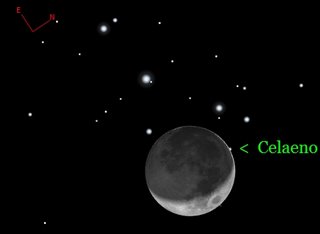20060401 - Celaeno Graze and Other Pleiades Occulted
[Updated with links to other observer reports.]
Session Name: 20060401.1730
--------------------------------------------------------
Location: Staten Island September 11 Memorial, NYC
Site Classification: Urban
Dates/times: 01 April 2006, 5:30pm ~ 9:45pm
Handheld Binos: Fuji 7x50
Tripod-mounted Binos: Takahashi 22x60, fov - 2.1°
===================================
Saturday
Transparency/Seeing (1 worst - 5 best): -/-
NELM: -
Conditions: Gusty winds, cloud cover changing from 50% - 80%
Observing party: Ben, Charlie, Kin, and myself
====================================
References
M45 at SEDS
Charlie's Occultation map for Celaeno event 01 April Report 05 April Update
Did Ben write up a report? Yes, he did.
---------------------------------------------------
 Last night, Team TotL took a class act trip to Staten Island to observe a grazing event. This was a first for me - I think for both Kin and Ben, as well - and absolutely worthwhile and fun. Moon was traveling eastward across the sky occulting the background stars of Pleiades. One of the Seven Sister stars, Celaeno, was grazed by the limb of Moon, causing it to blink on and off. Caught up in all the excitement , I think we called out 3 or 4 times each for the disappearance and reappearance of the star. We were an unrehearsed cacophany of shouting geese. I really don't remember what I was shouting. "Blink", "In", "Out", I think were some of the terms I used. For me it sounded as if we were all 'pretty much' close together in calling it out but the others said that was not the case.
Last night, Team TotL took a class act trip to Staten Island to observe a grazing event. This was a first for me - I think for both Kin and Ben, as well - and absolutely worthwhile and fun. Moon was traveling eastward across the sky occulting the background stars of Pleiades. One of the Seven Sister stars, Celaeno, was grazed by the limb of Moon, causing it to blink on and off. Caught up in all the excitement , I think we called out 3 or 4 times each for the disappearance and reappearance of the star. We were an unrehearsed cacophany of shouting geese. I really don't remember what I was shouting. "Blink", "In", "Out", I think were some of the terms I used. For me it sounded as if we were all 'pretty much' close together in calling it out but the others said that was not the case.We are patiently waiting for Charlie to reduce his data and hopefully publish it to his blog. Charlie brought along a mixer where a shortwave radio for timing signals fed one channel and his recorded his voice to another. We were all hoping to hear our voices in the background but early indicators seem that only Charlie's was picked up.
Charlie, Kin, and myself had binoculars all in the 15x - 22x range. Ben came with his TV76 Apo telescope. He swapped EPs for a ~22x and ~48x. Everyone was comfortable with their optics which were adequate to observe this event. The wind was a force that needed to be reckoned with. At first we were setup in the open of the esplanade, catching the full force of the wind. We observed the grazing event from here. Charlie and Kin also watched Electra dissappear. Funny, it doesn't take much to miss an event. Simply take your eye away from the EP and you can kiss opportunity goodbye.
After the graze we relocated to one end inside the Memorial looking over the Wall. Our intent was to observe the occultations sheilded from the wind but it didn't help much. For the dimmer stars , mag ~6.5 & fainter, it was difficult. However for the brighter stars it wasn't as bad.
---------
All day leading up to the event it was cloudy. I mean entirely overcast with a threatening look of rain. Charlie insisted that he was going because if the weather to a turn for the better than he would have no regrets. A good thing that we followed his lead.
Throughout the evening the clouds were a pain. We were fortunate that when the occultations occurred the clouds would clear. There was one, probably miss, that clouds did not clear. It's the star that is fainter and nearby Maia at a 4:00~ish position, seen on the SEDS photo. That one, SAO 76152 seemed like it was on good course for a graze. As Moon approached it, it didn't appear as close to the limb as Celaeno did. Celaeno was very close to the limb for a good period and it was tough to resolve any separation. It was obvious to see the full starlight as a pimple on he limb of the darkside of Moon. Never did I see the starlight maginitude diminish rather than completely blink off.
Of the brighter, named stars we would watch Electra, Merope, Alcyone, Atlas, and Pleione disappear and reappear. Asterope I & -II, Maia, Taygeta were not part of the event from our location. It is hard for one to disregard the fact nearby Moon is travelling across the sky wher its motion is easily observed by the background stars of the cluster. At times I would try to estimate when an event would occur but I was off erring to too long. Things happened quickly up there.
At the very end, we were waiting for Atlas to reappear. It was nearly 9:30pm and Moon was caught behind this thin cigar~ish shaped cloud. From the behaviour of previous clouds we thoughtthis one would pass quickly by. It didn't. Moon was caught behind there for good lengths. ocassionally punching through. We finally picked up Atlas clear of Moon and called it a night. Naturally, as we walked towards the ferry with our optics and tripods strapped to our backs, a look over our shoulder displayed a golden, crescent Moon hanging above the horizon very much in the clear.
- peter
<< Home